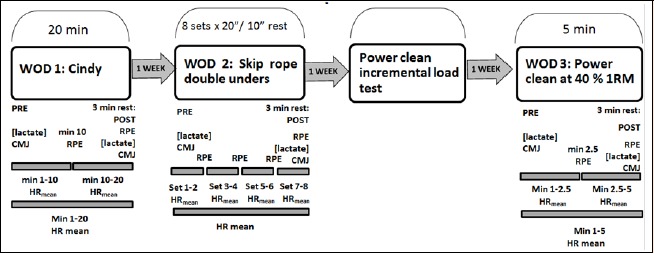Abstract
CrossFit® consists of workouts of the day (WODs) in which different exercises are conducted at high intensity with minimal or no rest periods. This study sought to quantify exercise intensity and muscular fatigue in the three CrossFit® session modalities: gymnastics (G), metabolic conditioning (M) and weightlifting (W). Thirty two, young, strength-trained, healthy men completed the three WODs: G (“Cindy”), M (double skip rope jumps) and W (power cleans). The variables measured in the sessions were: mean heart rate (HR), rate of perceived exertion (RPE), blood lactate [lactate], and jump height (H), average power (AP) and maximum take-off velocity (Vmax) in a counter movement jump test. In all three WODs, elevated HR values (≥90% of the theoretical HRmax) were recorded at the time points mid-session and end-session. Mean RPEs were 17.6 ± 1.6 (G WOD), 16.0 ± 2.3 (M WOD), and 15.7 ± 2.0 (W WOD). Postexercise [lactate] was higher than 10 mmol·L-1 for the three WODs. Following the G (“Cindy”) and W (power cleans) WODs, respectively, significant muscular power losses were observed in H (7.3% and 8.1%), Vmax (13.8% and 3.3%), AP relative (4.6% and 8.3%) and AP total (4.2% and 8.2%) while losses in the M WOD were not significant (p > 0.05). A vigorous intensity of exercise was noted in all three WODs, with greater mean HRs detected in the “Cindy” and skip rope WODs than power clean WOD. Muscular fatigue was produced in response to the “Cindy” and power clean WODs but not the skip rope WOD.
Key points.
A vigorous intensity of exercise was noted in “Cindy”, Double Skip Rope jumps and Power Cleans WODs.
Such high intensities of exercise have been related to cardioprotective benefits and described as a better way of improving VO2max compared to more moderate work intensities
However, trainers and exercise professionals need to be cautious when prescribing such high training intensities by making sure that individuals assigned to any Crossfit® program are free of any cardiovascular or respiratory conditions or injuries that could jeopardize their health.
The muscular fatigue observed here for the “Cindy” and Power Cleans WODs, but not for the Skip Rope Double Unders, suggests that for any high intensity exercise, recovery periods are essential to avoid muscle fatigue and injury.
Key words: Heart rate, cardiovascular responses, countermovement test, high intensity interval training, blood lactate, muscle fatigue
Introduction
CrossFit® is a relatively new sport’s modality of training and competition that has recently exponentially expanded worldwide. Its exercises cover many movement patterns and are conducted at high intensity (Glasmann, 2007). Training is organized as daily sessions called “workouts of the day” or WODs. These WODs are executed with short or no rest periods, and combine exercises and movements in the form of a circuit (Glasmann, 2007). The objective of some of these exercises is to achieve the best time possible, while for others the goal is to complete as many rounds as possible over periods of 10 to 20 minutes (Smith et al., 2013). According to the contents of the WOD, there are three session modalities: gymnastics (G), in which the work involves the body itself (pull-ups, rope climb, push-ups, ring row exercises, air squats, burpees, etc.); metabolic conditioning (M), including cardiovascular exercises such as running, rowing, or skip rope; and finally weightlifting (W), consisting of Olympic lifts (snatch, clean and jerk), deadlifts, squats, or overhead press lifts using, for example, kettlebells, sandbags, or medballs (Maté-Muñoz et al., 2017). Thus, although the different CrossFit® sessions vary widely in their exercises and movement patterns, they share the feature that training is performed at high intensity with little or no rest periods. However, the workloads used in each exercise are not controlled and preestablished workloads can be excessive for some individuals (Weinsenthal et al., 2014). Further, few studies have examined physiological responses to these WODs. In a recent study, Fernández-Fernández et al. (2015) determined in a group of subjects with CrossFit® experience, acute physiological responses (VO2, oxygen consumption; HR, heart rate, [lactate], blood lactate concentration and RPE, rate of perceived exertion) to a W and G type WOD known respectively as “Fran” (thrusters + pull ups) and “Cindy” (pull-ups, push-ups, air squats). According to these responses, both WODs were described as high intensity (HRmean = 90-95 % HRmax; [lactate] > 14 mmol-1; RPE > 8). When cardioresponses to the “Cindy” WOD were examined in another study in participants with little experience with CrossFit® (Kliszczewicz et al., 2014), HRmean = 91 ± 4.2 % HRmax, a rate equivalent to vigorous exercise according to the American College of Sports Medicine (ACSM) (Garber et al., 2011), and VO2 = 63.8 ± 12.3 % VO2max, also considered to indicate vigorous exercise (Kliszczewicz et al., 2014). Butcher et al., (2015) examined HR and RPE responses to two G type WODs. One included rest intervals (total 21 min of exercise, 6 sets of 60 s of 8 bench press + 10 kipping pull-ups or ring rows and box jumps for the remainder of the 60 s, and 3 min of rest) and the other WOD was 20 min of “Cindy” without rest. Results indicated that although both WODs gave rise to high HRs and similar RPEs, significant differences were produced in HRmean (87.6 ± 5.6 for Cindy vs. 76.4 ± 7.3% HRmax, P = 0.01).
Hence, although CrossFit® sessions can vary widely, very few work intensities have been quantified for the different WODs, with “Cindy” being the most widely analyzed.
Quantifying the intensity of exercise of different CrossFit® sessions will provide information about adequate training loads. As the training load has been linked to a risk of injury and/or disease (Drew and Finch, 2016), prescribing adequate training loads will lead to beneficial physical and physiological adaptations, reducing the risks of injury and thus increasing the probability of competition success (Fox et al., 2018).
Only one study has compared CrossFit® WODs with and without rest intervals. In a recent study by Maté-Muñoz et al. (2017), it was noted that high intensity exercise without intervals, like the “Cindy” WOD or 5 min of power cleans, generated muscular fatigue, whereas muscular fatigue produced in response to a high-intensity interval exercise (double skip rope jumps), disappeared after 3 min of rest.
Muscular fatigue has been defined as any exercise-induced reduction in the maximal voluntary force or power produced by a muscle or muscle group (Bigland-Ritchie and Woods, 1984, Gandevia, 2001). This fatigue has a significant negative impact on performance (Meeusen et al., 2013) and has been related to a risk of injury due to biomechanical modification of the movement (Weisenthal et al., 2014). Hence, it is essential to quantify the muscular fatigue and intensity of Crossfit® WODs for training prescription and to elicit optimal adaptations, reducing the risk of injury.
Accordingly, the objectives of this study were: 1) to quantify the intensity of exercise and measure muscular fatigue during 3 CrossFit® WODs involving different movement patterns with varying work volumes and rest periods, and 2) to compare the different physiological and mechanical responses to the 3 WODs.
Methods
Experimental approach to the problem
To compare exercise intensity and muscular fatigue across the three different CrossFit® modalities, 4 exercise sessions were completed in 4 consecutive weeks in the order: Session 1 – WOD 1 or G WOD, consisting of “Cindy”; Session 2 – WOD 2 or M WOD, consisting of double skip rope jumps; Session 3 – incremental power clean test (Olympic lifts) to calculate the maximum lifting strength of the individual; and Session 4 – WOD 3 or W WOD, consisting of power cleans.
All sessions were completed on the same week day within the same three hour time window. The rest period between each session was one week. Ambient conditions for all sessions were the same (temperature: 21-25° C, atmospheric pressure: 715-730 mm Hg, and relative humidity: 40-50%). Exercises were executed in the CrossFit® Box of the Universidad de Alfonso X El Sabio, Madrid, Spain (see Figure 1 for experimental design).
Figure 1.

Experimental design. The 3 modalities of CrossFit® WODs examined in this study were: Gymnastics (Cindy), Metabolic conditioning (Crossfit® skip rope double-unders) and Weightlifting (power cleans). The figure shows the work/rest times and the time points in each WOD for the [lactate], heart rate, rate of perceived exertion and countermovement jump (CMJ) determinations.
Subjects
The subjects selected for this study were 32 healthy men who were students of the degree course in Physical activity and Sport Sciences. Mean participant age was 21.75 ± 2.54 years, weight 76.85 ± 7.26 kg, height 1.79 ± 0.06 m and body mass index (BMI) 23.99 ± 1.70 kg·m-2. Participants’ experience was more than 6 months of strength training, including free weight and Olympic lifts in their training routines. No subject consumed any type of medication or performance-enhancing drugs during the study. Further exclusion criteria were cardiovascular, metabolic, neurologic, or lung disease, or any orthopedic condition that could limit performance of the exercises. None of the participants had experience with CrossFit® WODs. Elite athletes were also excluded. In the 48 hours before each exercise session, it was required that subjects refrained from physical exercise, smoking or the intake of caffeine or alcohol.
After receiving an explanation of the nature of the study, written informed consent was obtained from each participant. The study design was in line with the tenets of the Declaration of Helsinki and received approval from the ethics committee of the University.
Exercise sessions
Power clean incremental load test: One week before WOD 3 (W type), an incremental load power clean test was conducted to determine each individual’s maximum strength or 1RM. This test has been described in detail elsewhere (Maté-Muñoz et al., 2017). One week before the study onset, the subjects practiced the power clean with the help of a qualified weightlifting trainer (Figure 1).
Warm up: Before each WOD or the incremental test, a warm-up was performed consisting of 5 min of low intensity running followed by 5 min of joint mobility and dynamic stretching exercises.
WOD 1 (G): “Cindy” The gymnastics WOD was the “Cindy” workout (Kliszczewicz et al., 2014, Kliszczewicz et al., 2015). This WOD consists of as many rounds possible of 5 pull-ups, 10 push-ups and 15 air squats in 20 min. Each round had to be properly executed according to preestablished minimum standards to continue onto the next round. One of the authors was responsible for counting rounds using a hand held counter. The techniques used for each exercise have been described in detail elsewhere (Maté-Muñoz et al., 2017). For the pull-ups, butterfly or kipping variations were avoided as the subjects did not have sufficient experience with these movements (Figure 1).
WOD 2 (M): CrossFit® skip rope double unders The metabolic conditioning WOD consisted of double skip rope jumps (CrossFit® double unders) conducted as high-intensity interval training (HIIT). For the intermittent training protocol (Tabata et al., 1996), subjects completed as many double unders as possible in 8 sets of 20 s with 10 s of rest between sets. Test duration was 4 minutes. The number of double unders completed per set was counted by an observer while another observer guided the time periods of work and rest (Figure 1).
WOD 3 (W): power cleans The weight lifting WOD consisted of the maximum number of power cleans possible in 5 min lifting a load equivalent to 40% of the individual’s 1RM determined 1 week previously. An observer counted the total number of power cleans completed (Figure 1).
Response measurements
Heart rate: Before each of the WOD sessions, subjects were fitted with a HR monitor (Polar RS-800CX; Polar Electro OY, Kempele, Finland). Heart rate data were stored and subsequently extracted using the software Polar Pro-Trainer 5. During each WOD, HRmean values were recorded as follows: WOD 1, for the whole trial and for minutes 1-10 and 10-20; WOD 2, for the whole trial and for sets 1 and 2 (S2), 3 and 4 (S4), 5 and 6 (S6) and 7 and 8 (S8); and WOD 3 for the whole trial and for minutes 1-2.5 and 2.5-5 (Figure 1). The equation used to calculate HRmax for each participant, with which the HR data obtained for each WOD were compared, was 208 – 0.7 x age (Tanaka et al. 2001).
Blood lactate concentrations: Before warm-up and at the end of each WOD, a finger prick blood sample (5 µl) was obtained by a single operator to determine blood lactate concentrations [lactate] in a portable analyzer (Lactate Pro LT-1710, Arkray Factory Inc., KDK Corporation, Siga, Japan) validated for this purpose (McNaughton, et al., 2002; Mclean et al., 2004).
Perceived exertion: The rate of perceived exertion was recorded using a 6-20 Borg scale (Borg 1970) as ranging from very, very light to very, very heavy. RPEs at the levels cardiopulmonary, muscular and general were recorded in minute 10 and at the end of the trial (minute 20) in WOD 1, in minute 2.5 and at the end of the trial (minute 5) in WOD 2, and in S2, S4, S6 and S8 in WOD 3. To help the participants to differentiate between the different RPE levels, they were instructed to think about whether their feeling of exertion involved the heart and lungs (RPE cardiopulmonary), the muscles used in the exercise (RPE muscular), or if they had a feeling of general exertion affecting the heart, lungs and muscles (RPE general).
Muscular fatigue: Muscular fatigue in the legs was assessed by measuring vertical reaction forces (0-10 kN; sampling velocity 0.5 kHz) in a countermovement jump (CMJ) (Gorostiaga et al., 2010) on a portable, 92 x 92 x 12.5 cm force platform (Quattro Jump model 9290AD; Kistler Instruments, Winterthur, Switzerland) before and 3 minutes after completing each WOD. The jump was initiated while standing on the platform with legs extended and hands on hips. For the jump, the legs are first flexed to 90° (eccentric action) and then explosively extended in a coordinated manner (concentric action) aiming for maximum height. During the flight stage, the knees are extended. Contact with the ground is made with the toes first. During the test, subjects kept their hands on their hips and avoided sideways displacements during the flight stage.
At each established time point, participants undertook 3 jumps separated by 30 s so that mean values could be recorded for: jump height (H), maximum take-off velocity (Vmax) average power relative (APR), and average power total (APT). All variables were calculated using vertical ground reaction force (GRF) data obtained using a force platform. The vertical component of center of mass (COM) velocity was estimated using the impulse method (Linthorne, 2001). Net impulse was obtained by integrating the GRF from 2 seconds before the first movement of the participant (Street et al., 2001) using the trapezoid method. Subsequently, the vertical velocity of COM was calculated by dividing the net impulse by the participant’s body mass (Floría et al., 2016). Vmax (m·s-1) was taken as the maximum velocity attained at the end of the concentric phase of the jump, just before take-off. H (cm) was defined as the maximum distance covered by the participant during a vertical jump calculated by double integration of the force. In other words it was calculated from Vmax of the COM just before take-off, and considering the deceleration effect of gravity [(Vmax)2/2 X 9.81], where Vmax is the maximum velocity just before take-off and 9.81 is acceleration due to gravity. Power was determined from the unfiltered force–time history using the impulse momentum principle (Owen et al., 2014). ART (watts·kg-1) was calculated as the product of the average velocity and vertical component of the GRF of the whole jump in relation to a kg of body mass (GRF x COM velocity). APT (watts) was the average power recorded for the total body weight of each individual.
GRF measurements can help identify symptoms of muscular fatigue arising from the reduced production of force (Ortega et al., 2010; Barker et al., 2018). These variables were selected on the grounds that jump height and power losses during an exercise session have been defined as indicators of mechanical and neuromuscular fatigue (Sánchez-Medina and González-Badillo, 2011) due to decreased muscle control, coordination, and force-generating capacity after fatigue (Cooper et al, 2018). An increased curvature of the force–velocity relationship could mainly indicate a loss of power thus delaying the contractile properties of skeletal muscle as one of the characteristic features of fatigue (Jones, 2010).
Statistical analysis
The normal distribution of the data was first checked using the Shapiro-Wilk test. Relationships between the cardiometabolic variables (HR and [lactate)] and RPE were established through Pearson’s correlation and linear regression. To compare data reflecting intensity of exercise (HR, [lactate], RPE) across the different CrossFit® WODs, we used one-factor ANOVA, after first checking for homogeneity of variance using Levene statistics. In cases of non homogeneous variance (p <.05), a non-parametric ANOVA was performed (Kruskall-Wallis).
To quantify muscular fatigue pre-post exercise in the different WODs, a Student t-test for paired samples was used. Percentage improvements in the CMJ test were calculated using the equation [post - pre]/pre X 100. Linear regression was used to assess correlations between [lactate] and the jump height and power variables.
Also, to compare the effects of metabolic and muscular fatigue among the three WODs, we used a with repeated measures two-way analysis of variance, once we had confirmed the homogeneous variances of the initial variables through Levene statistics. That is, we considered an inter-subject factor, or Group effect (3 levels: WOD 1, WOD 2, WOD 3) and an intra-subject factor, or Time effect (2 levels: preexercise, postexercise) as well as the effect of the interaction general linear model between the two. When significant differences were observed in the interaction Group x Time (p < 0.05), one-way ANOVAs with post-hoc Bonferroni correction were performed to compare differences among the sessions (WOD 1, WOD 2, WOD 3).
All data are provided as their means (M) and standard deviations (SD) and ± 95% confidence intervals (CI). In general linear model, effect size (ES) and statistical power (SP) were calculated. Significance was set at p < 0.05. All statistical tests were performed using the software package SPSS version 20.0 (SPSS, Chicago, III).
Results
The results recorded for the three CrossFit® WODs (“Cindy” rounds in WOD 1, double unders in each set of WOD 2 and power cleans executed in the 5 minutes’ duration of WOD 3) are provided in Table 1.
Table 1.
Results recorded in the three CrossFit® WODs. Data are means ± SD.
| Variables | Skip rope double unders |
|---|---|
| Rounds (n) | 14.00 ± 7.90 |
| Double unders: Set 1 (n) | 14.00 ± 7.90 |
| Set 2 (n) | 12.90 ± 7.38 |
| Set 3 (n) | 12.00 ± 6.54 |
| Set 4 (n) | 9.87 ± 4.98 |
| Set 5 (n) | 10.90 ± 5.78 |
| Set 6 (n) | 10.09 ± 5.08 |
| Set 7 (n) | 10.46 ± 5.26 |
| Set 8 (n) | 9.53 ± 5.13 |
| Power cleans (n) | 109.37 ± 24.83 |
| “Cindy” | 23.53 ± 3.88 |
Maximum heart rate: In Table 2 we provide the HRmax values recorded in the three WODs in relation to theoretical maximum HR values (Tanaka et al., 2001). These data indicate elevated HR recorded both at the mid-session and end-session time points in all three WODs. With the exception of the HRmean observed in WOD 3 (~89%), all HRs were 90% of the theoretical HRmax, indicating the high cardiovascular demands of the three types of exercise.
Table 2.
Descriptive statistics for HR recorded in the WODs in relation to theoretical HRmax (Tanaka et al. 2001).
| WOD 1 (Cindy) | Mean ± SD |
|---|---|
| HRmax theoretical (bpm) | 193 ± 2 |
| HR Min 10 (bpm) | 184 ± 10 |
| % HRmax theoretical Min 10 | 95 ± 5 |
| HR Min 20 (bpm) | 187 ± 9 |
| % HRmax theoretical Min 20 | 97 ± 5 |
| HRmean (bpm) | 178 ± 9 |
| % HRmax theoretical average | 92 ± 5 |
| WOD 2 (skip rope double unders) | |
| HRmax theoretical (bpm) | 193 ± 2 |
| HR S2 (bpm) | 177 ± 11 |
| % HRmax theoretical S2 | 92 ± 2 |
| HR S4 (bpm) | 182 ± 9 |
| % HRmax theoretical S4 | 94 ± 5 |
| HR S6 (bpm) | 183 ± 8 |
| % HRmax theoretical S6 | 95 ± 4 |
| HR S8 (bpm) | 183 ± 8 |
| % HRmax theoretical S8 | 95 ± 4 |
| HRmean (bpm) | 178 ± 9 |
| % HRmax theoretical average | 92 ± 5 |
| WOD 3 (power cleans) | |
| HRmax theoretical (bpm) | 193 ± 2 |
| HR Min 2.5 (bpm) | 178 ± 11 |
| % HRmax theoretical Min 2.5 | 92 ± 6 |
| HR Min 5 (bpm) | 185 ± 10 |
| % HRmax theoretical Min 5 | 96 ± 5 |
| HRmean (bpm) | 171 ± 11 |
| % HRmax theoretical average | 89 ± 6 |
HRmax = maximum heart rate; bpm = beats per minute; % = percentage; S2 = set 2; S4; set 4; S6 = set 6; S8 = set 8; WOD 1 = G modality CrossFit® Workout of the Day (“Cindy”); WOD 2 = M modality CrossFit® Workout of the Day (skip rope double unders); WOD 3 = W modality CrossFit® Workout of the Day (power cleans).
The RPEs recorded at the end of the exercise sessions are provided in Table 3 for each WOD.
Table 3.
Descriptive statistics for RPEs recorded at the end of the three WODs. Data are means ± SD.
| WOD 1 | RPE Muscular | 16.96 ± 1.97 |
| RPE Cardio | 17.09 ± 1.69 | |
| RPE General | 17.62 ± 1.60 | |
| WOD 2 | RPE Muscular | 15.68 ± 2.91 |
| RPE Cardio | 16.12 ± 2.18 | |
| RPE General | 16.00 ± 2.32 | |
| WOD 3 | RPE Muscular | 15.53 ± 2.10 |
| RPE Cardio | 15.00 ± 1.90 | |
| RPE General | 15.65 ± 2.02 |
RPE = rate of perceived exertion; n = numbers; WOD 1 = G modality CrossFit® workout of the day (“Cindy”); WOD 2 = M modality CrossFit® workout of the day (skip rope double unders); WOD 3 = W modality CrossFit® workout of the day (power cleans).
Heart rate, lactate, and rate of perceived exertion: The correlations detected among the cardiometabolic factors and RPE were: 1) positive and strong correlation (|r| > 0.70) between [lactate] and HR across the three WODs (WOD 1 r = 0.938; p < 0.01; R2 = 0.880 p < 0.01; WOD 2 r = 0.915; p < 0.01; R2 = 0.838 p < 0.01; WOD 3 r = 0.933; p < 0.01; R2 = 0.870 P<0.01); 2) moderate correlation (0.30 ≤ |r| ≤ 0.70) between HR and RPE in WOD 2 (RPE muscular r = 0.330; p < 0.01; R2 = 0.109; RPE cardio r = 0.361; p < 0.01; R2 = 0.130; RPE general r = 0.361, p < 0.01; R2 = 0.130); and 3) weak correlation (|r| < 0.30) between HR and RPE cardio in WOD 1 (r=0.314; p < 0.011, R2 = 0.099). No correlation was observed between HR and RPE for WOD 3 (Table 4).
Table 4.
Correlations detected between cardiometabolic factors and RPE used to indicate the work intensities of the three Crossfit® WODs.
| Pearson | Linear regression | ||||
|---|---|---|---|---|---|
| r | P | R2 | P | ||
| WOD 1 | [Lactate] (IF) VS. HR (IF) | 0.938 | 0.000 | 0.880 | 0.000 |
| HR (Min10-Min20) VS. RPE M (Min10-Min20) | -0.091 | 0.473 | 0.008 | 0.473 | |
| HR (Min10-Min20) VS. RPE C (Min10-Min20) | 0.314 | 0.011 | 0.099 | 0.011 | |
| HR (Min10-Min20) VS. RPE G (Min10-Min20) | 0.155 | 0.221 | 0.024 | 0.221 | |
| WOD 2 | [Lactate] (IF) VS. HR (IF) | 0.915 | 0.000 | 0.838 | 0.000 |
| HR (S2-S4-S6-S8) VS. RPE M (S2-S4-S6-S8) | 0.330 | 0.000 | 0.109 | 0.000 | |
| HR (S2-S4-S6-S8) VS. RPE C (S2-S4-S6-S8) | 0.361 | 0.000 | 0.130 | 0.000 | |
| HR (S2-S4-S6-S8) VS. RPE G (S2-S4-S6-S8) | 0.361 | 0.000 | 0.130 | 0.000 | |
| WOD 3 | [Lactate] (IF) VS. HR (IF) | 0.933 | 0.000 | 0.870 | 0.000 |
| HR (Min2.5-Min5) VS. RPE M (Min2.5- Min5) | -0.033 | 0.794 | 0.001 | 0.794 | |
| HR (Min2.5- Min5) VS. RPE C (Min2.5-Min5) | 0.103 | 0.419 | 0.011 | 0.419 | |
| HR (Min2.5- Min5) VS. RPE G (Min2.5-Min5) | 0.036 | 0.779 | 0.001 | 0.779 | |
IF = Initial-Final; HR = Heart rate; RPE = Rate of perceived exertion; Min2.5 = minute 2.5; Min5 = minute 5; Min10 = minute 10; Min20 = minute 20; M = Muscular; C = Cardio; G = General; S2 = Set 2; S4 = Set 4; S6 = Set 6; S8 = Set 8; WOD 1 = G modality CrossFit® workout of the day (“Cindy”); WOD 2 = M modality CrossFit® workout of the day (skip rope double unders); WOD 3 = W modality CrossFit® workout of the day (power cleans).
The different variables reflecting work intensity are compared across the WODs in Table 5. Thus, one-way ANOVA detected significant differences among WODs in HRmean (F = 4.839, p ≤ 0.01), final [lactate] (F=3.557 p ≤ 0.05) and in RPE muscular (F =3.548 p ≤ 0.033), RPE cardio (F =9.38 p ≤ 0.01), and RPE general (F =8.782 p ≤ 0.01), while no differences were detected in final HR (F=1.859 p > 0.05). As no homogeneity of variance was observed for resting [lactate], the non-parametric Kruskall-Wallis was used, indicating significant differences between WOD 1 and WOD 3 (p = 0.036). Further, pairwise comparisons revealed significant differences in HRmean between WOD 1 and WOD 3 (p = 0.024), and between WOD 2 and WOD 3 (p = 0.026). For final [lactate], differences were noted between WOD 1 and WOD 2 (p = 0.032). Finally, for the RPE scores obtained after exercise, significant differences were found between WODs 1 and 3 in RPE muscular (p = 0.05), RPE cardio (p = 0.000) and RPE general (p = 0.001). Further, RPE general differed significantly between WODs 1 and 2 (p = 0.005). No differences emerged in the remaining pairwise comparisons.
Table 5.
Comparing cardiometabolic variables and RPE among the three CrossFit® WODs.
| Variable | WOD | M ± SD | CI (95%) | P |
|---|---|---|---|---|
|
HR final (bpm) |
1 | 187 ± 9 | 184 to 191 | 0.161 |
| 2 | 183 ± 8 | 180 to 186 | ||
| 3 | 185 ± 10 | 181 to 188 | ||
|
HRmean (bpm) |
1 | 178 ± 9§ | 175 to 182 | 0.010 * |
| 2 | 178 ± 9║ | 175 to 181 | ||
| 3 | 171 ± 11 | 167 to 176 | ||
|
[Lactate] rest (mmol·L-1) |
1 | 1.55 ± 0.61 § | 1.33 to 1.76 | 0.016† |
| 2 | 1.30 ± 0.37 | 1.17 to 1.44 | ||
| 3 | 1.23 ± 0.32 | 1.12 to 1.35 | ||
|
[Lactate] final (mmol·L-1) |
1 | 12.02 ± 2.12 ‡ | 11.25 to 12.79 | 0.032 † |
| 2 | 10.37 ± 2.91 | 9.32 to 11.43 | ||
| 3 | 11.49 ± 2.46 | 10.61 to 12.38 | ||
|
RPE final Muscular |
1 | 16.96 ± 1.97 § | 16.26 to 17.68 | 0.033† |
| 2 | 15.68 ± 2.91 | 14.64 to 16.74 | ||
| 3 | 15.53 ± 2.10 | 14.77 to 16.29 | ||
|
RPE final Cardio |
1 | 17.09 ± 1.69 § | 16.48 to 17.70 | 0.000 * |
| 2 | 16.12 ± 2.18 | 15.34 to 16.91 | ||
| 3 | 15.00 ± 1.90 | 14.31 to 15.69 | ||
|
RPE final General |
1 | 17.62 ± 1.60‡§ | 17.05 to 18.20 | 0.000 * |
| 2 | 16.00 ± 2.32 | 15.16 to 16.84 | ||
| 3 | 15.65 ± 2.02 | 14.93 to 16.39 |
HR = heart rate; RPE = rate of perceived exertion; bpm = beats per minute; CI = confidence interval; WOD 1 = G modality CrossFit® workout of the day (“Cindy”); WOD 2 = M modality CrossFit® workout of the day (skip rope double unders); WOD 3 = W modality CrossFit® workout of the day (power cleans)
* = significant difference between WODs; p≤0.01.
† = significant differences between WODs; p <0.05.
‡ = significant difference WOD 1 vs 2 (p≤0.05).
§ significant difference WOD 1 vs 3 (p≤0.05).
║, significant difference WODs 2 vs 3 (p ≤0.05).
Countermovement jump height and average power losses
WOD 1: The CMJ variables found to differ significantly pre-postexercise in this WOD were jump height (M = 2.597 cm, CI 95% = 1.742 – 3.452, t = 6.195; ES = 1.094, p = 0.000) (Table 6), and maximum take-off velocity (Vmax), average power relative (APR) and average power total (APT) (M = 0.34 m·s-1, CI 95% = 0.23 – 0.46, t = 6.164; ES = 1.089, p = 0.000, M = 1.42 watts·kg-1, CI 95% = 0.49 – 2.35, t = 3.127; ES = 0.552, p = 0.004, and M = 98.62 watts, CI 95% = 27.95 – 169.30, t = 2.846; ES = 0.502, p = 0.008, respectively).
Table 6.
Variables related to muscular and metabolic fatigue recorded in the three WODs.
| Variables | WOD | Pre | Post | Effect Size | P Group effect | P Time effect | P Interaction Group x Time |
|---|---|---|---|---|---|---|---|
|
Lactate] (mmol·L-1) |
1 | 1.55 ± 0.61 | 12.02 ± 2.12 | -5.046 | 0.017* | 0.000* | 0.063 |
| 2 | 1.30 ± 0.37 | 10.37 ± 2.91 | -3.022 | ||||
| 3 | 1.23 ± 0.32 | 11.49 ± 2.59 | -4.245 | ||||
| H (cm) | 1 | 37.99 ± 4.42 | 35.39 ± 4.69 | 1.094 | 0.381 | 0.000* | 0.213 |
| 2 | 37.05 ± 4.37 | 36.63 ± 4.66 | 0.288 | ||||
| 3 | 36.57 ± 4.13 | 33.82 ± 4.97 | 1.050 | ||||
| Vmax (m·s-1) | 1 | 2.88 ± 0.15 | 2.53 ± 0.30 | 1.089 | 0.015* | 0.000* | 0.000* |
| 2 | 2.84 ± 0.15 | 2.81 ± 0.17 | 0.309 | ||||
| 3 | 2.83 ± 0.13 | 2.74 ± 0.17 | 0.872 | ||||
| APR (watts·kg-1) | 1 | 32.23 ± 3.00 | 30.81 ± 4.13 | 0.552 | 0.078 | 0.000* | 0.013* |
| 2 | 31.59 ± 3.36 | 30.96 ± 3.92 | 0.298 | ||||
| 3 | 30.89 ± 3.31 | 28.53 ± 3.85 | 1.091 | ||||
| APT (watts) | 1 | 2463.48 ± 287.42 | 2364.85 ± 398.95 | 0.502 | 0.164 | 0.000* | 0.011* |
| 2 | 2424.44 ± 299.49 | 2382.08 ± 375.99 | 0.282 | ||||
| 3 | 2364.68 ± 305.99 | 2186.36 ± 315.76 | 0.958 |
H = jump Height; Vmax = maximum takeoff velocity; APR = average power relative; APT = average power total. Pre = Preexercise; Post = Postexercise; WOD 1 = G modality CrossFit® workout of the day (“Cindy”); WOD 2 = M modality CrossFit® workout of the day (skip rope double unders); WOD 3 = W modality CrossFit® workout of the day (power cleans).
* Significant difference (p < 0.05).
WOD 2: In this WOD, no pre-postexercise differences were observed in any of the jump ability variables (Table 6) (H: M = 0.42 cm, CI 95% = -0.10 – 0.93, t = 1.631; ES = 0.288, p = 0.113, Vmax: M = 0.03 m·s-1, CI 95% = -0. 01– -0.07, t = 1.749; ES = 0.309, p = 0.090, APR: M = 0.63 watts·kg-1, CI 95% = -0.13 – 1.38, t= 1.689; ES= 0.298, p = 0.101, APT: M = 42.36 watts, CI 95% = -11.73 – 96.46, t = 1.597; ES = 0.282, p = 0.120).
WOD 3: In response to WOD 3, significant reductions were observed 3 minutes after exercise in all the jump ability variables examined (H: M = 2.76 cm, CI 95% = 1.81 – 3.70, t = 5.948; ES = 1.050, p = 0.000, Vmax: M = 0.09 m·s-1, CI 95% = 0.05 – 0.13, t = 4.941; ES = 0.872, p = 0.000, APR: M = 2.35 watts·kg-1, CI 95% = 1.58 – 3.13, t = 6.178; ES = 1.091, p = 0.000, APT: M = 178.32 watts, CI 95% = 111.26 – 245.38, t = 5.423; ES = 0.958, p = 0.000) (Table 6).
Weak correlation was detected between the muscular fatigue indicators average power or jump height and [lactate] (|R2| < 0.30) (Table 7).
Table 7.
Correlations between muscular fatigue and blood lactate concentration in the three WODs.
| Linear regression | |||
|---|---|---|---|
| R2 | P | ||
| WOD 1 | H (Pre-Post) VS. [lactate] (Pre- Post) | 0.110 | 0.008* |
| APR (Pre-Post) VS. [lactate] (Pre- Post) | 0.090 | 0.016* | |
| APT (Pre-Post) VS. [lactate] (Pre- Post) | 0.081 | 0.023* | |
| WOD 2 | H (Pre-Post) VS. [lactate] (Pre- Post) | 0.141 | 0.002* |
| APR (Pre-Post) VS. [lactate] (Pre- Post) | 0.144 | 0.002* | |
| APT (Pre-Post) VS. [lactate] (Pre- Post) | 0.179 | 0.000* | |
| WOD 3 | H (Pre-Post) VS. [lactate] (Pre- Post) | 0.119 | 0.005* |
| APR (Pre-Post) VS. [lactate] (Pre- Post) | 0.167 | 0.001* | |
| APT (Pre-Post) VS. [lactate] (Pre- Post) | 0.123 | 0.004* | |
H =jump height, [lactate] = blood lactate concentration APR = average power relative, APT = average power total, Pre = preexercise, Post = postexercise, WOD 1 = G modality CrossFit® workout of the day (“Cindy”), WOD 2 = M modality CrossFit® workout of the day (skip rope double unders), WOD 3 = W modality CrossFit® workout of the day (power cleans).
* Significant difference (p<0.05).
Countermovement jump height and average power losses
WOD 1: The CMJ variables found to differ significantly pre-postexercise in this WOD were jump height (M = 2.597 cm, CI 95% = 1.742 – 3.452, t = 6.195; ES = 1.094, p = 0.000) (Table 6), and maximum take-off velocity (Vmax), average power relative (APR) and average power total (APT) (M = 0.34 m·s-1, CI 95% = 0.23 – 0.46, t = 6.164; ES = 1.089, p = 0.000, M = 1.42 watts·kg-1, CI 95% = 0.49 – 2.35, t = 3.127; ES = 0.552, p = 0.004, and M = 98.62 watts, CI 95% = 27.95 – 169.30, t = 2.846; ES = 0.502, p = 0.008, respectively).
WOD 2: In this WOD, no pre-postexercise differences were observed in any of the jump ability variables (Table 6) (H: M = 0.42 cm, CI 95% = -0.10 – 0.93, t = 1.631; ES = 0.288, p = 0.113, Vmax: M = 0.03 m·s-1, CI 95% = -0. 01– -0.07, t = 1.749; ES = 0.309, p = 0.090, APR: M = 0.63 watts·kg-1, CI 95% = -0.13 – 1.38, t= 1.689; ES= 0.298, p = 0.101, APT: M = 42.36 watts, CI 95% = -11.73 – 96.46, t = 1.597; ES = 0.282, p = 0.120).
WOD 3: In response to WOD 3, significant reductions were observed 3 minutes after exercise in all the jump ability variables examined (H: M = 2.76 cm, CI 95% = 1.81 – 3.70, t = 5.948; ES = 1.050, p = 0.000, Vmax: M = 0.09 m·s-1, CI 95% = 0.05 – 0.13, t = 4.941; ES = 0.872, p = 0.000, APR: M = 2.35 watts·kg-1, CI 95% = 1.58 – 3.13, t = 6.178; ES = 1.091, p = 0.000, APT: M = 178.32 watts, CI 95% = 111.26 – 245.38, t = 5.423; ES = 0.958, p = 0.000) (Table 6).
Weak correlation was detected between the muscular fatigue indicators average power or jump height and [lactate] (|R2| < 0.30) (Table 7).
Muscular fatigue and blood lactate concentrations
Significant pre-postexercise differences in [lactate] emerged among the three WODs (Table 6) (F = 1485.347; p = 0.000, ES = 0.941, SP = 1.000), and between WOD 1 and WOD 2 (F = 3.995; p = 0.021, ES = 0.075, SP = 0.703) (p = 0.017) after post hoc Bonferroni correction. In contrast, no significant effect on [lactate] was produced by the interaction Time x Group (F = 2.852; p = 0.063, ES = 0.058, SP = 0.547).
For the factor time, a significant loss in jump height was produced (F = 57.049; p = 0.000, ES = 0.380, SP = 1.000), without significant differences between groups, or WODs (F = 0.975; p = 0.381, ES = 0.021, SP = 0.215) nor Time x Group (F = 1.573; p = 0.213, ES = 0.033, SP = 0.326). For Vmax, significant differences were recorded in the factor time (F = 57.632; p = 0.000, ES = 0.383, SP = 1.000), Time x Group (F = 22.032; p = 0.000, ES = 0.321, SP = 1.000) and group (F = 4.402; p = 0.015, ES = 0.086, SP = 0.746). As differences were noted in the interaction Time x Group, we conducted a one-way ANOVA for the time point postexercise with Bonferroni post hoc correction to compare this variable among the different WODs. These data indicated that Vmax was significantly reduced in WOD 1 compared to WODs 2 and 3 (p = 0.000, p = 0.001 respectively).
The other variables related to muscular fatigue APR and APT showed significant reductions with the factor time (F = 39.590; p = 0.000, ES = 0.299, SP = 1.000 and (F = 34.151; p = 0.000, ES = 0.269, SP = 1.000, respectively), though differences among groups were not significant. In contrast, the interaction Time x Group did vary significantly for APR (F = 4.582; p = 0.013, ES = 0.090, SP = 0.764) and APT (F = 4.690; p = 0.011, ES = 0.092, SP = 0.775). A one-way ANOVA for the time point postexercise revealed a significant difference in APR between WODs 2 and 3 (p = 0.049).
Discussion
Given the wide variety of CrossFit® WODs employed, the objective of our study was to compare physiological and mechanical responses among WODs involving a high intensity of exercise but very different movement patterns. These WODs (designated here as 1, 2 and 3 respectively) were the G modality “Cindy”, which has been the focus of intense research, the M WOD consisting of CrossFit® skip rope double unders and rest periods (8 x 20 s/10 s rest), and the W WOD consisting of power cleans (5 min) without rest periods. Knowing the intensity of exercise and the muscular fatigue generated by the different Crossfit® WODs is useful for tailoring training loads to each individual. An adequate training load will induce beneficial adaptations and avoid injury or disease.
One of the findings of this study was the high intensity of exercise recorded in the three WODs which was measured in terms of cardiovascular variables, metabolic variables and of the subject’s perceived exertion.
Heart rate: When we examined exercise intensity at the cardiovascular level, HRs at the end of WODs 1, 2 and 3 respectively were 187 ± 10 bpm (97.2 ± 4.8 % HRmax), 183 ± 9 bpm (94.8 ± 4.5 % HRmax), and 185 ± 10 bpm (95.8 ± 5.4 % HRmax), with HRmean values recorded of 178 ± 10 bpm (92.5 ± 4.9 % HRmax) (WOD 1), 178 ± 9 bpm (92.4 ± 4.7 % HRmax) (WOD 2), and 172 ± 12 bpm (89 ± 6 % HRmax) (WOD 3). According to ACSM guidelines, these end-exercise HRs could be described as being close to that corresponding to maximum intensity exercise (Garber et al. 2011). However, if we consider the mean HR recorded throughout each session, this intensity of exercise would be considered vigorous and close to maximal (~90 % HRmax) as the ASCM defines this intensity as being between 77 and 95% of HRmax. Thus although no significant differences were detected in HRfinal among the different WODs, we did note a significantly higher HRmean for WODs 1 (“Cindy”) and 2 (skip rope double unders) than for WOD 3 (power cleans). This difference might be explained by the specific movement pattern of the power clean, as it is a loaded strength exercise generating high power outputs with a large contribution of glycolytic energy metabolism.
This high cardiovascular requirement noted for “Cindy” is comparable to that described by others who have provided mean HRs for this CrossFit® WOD of 182 ± 7 bpm (97.4 ± 2.4 % HRmax) (Fernández-Fernández et al., 2015), 171 ± 14 bpm (91 ± 4.2 % HRmax) (Kliszczewicz et al., 2014), 88 ± 6 % HRmax (Butcher et al., 2015), and 93.3 ± 1.2 % - 97.7 ± 1.9 % HRmax (Kliszczewicz et al., 2015). We also obtained a similar HRmean for our W or power clean WOD to the HRmean obtained for “Fran” (also a W WOD) in the study by Fernández-Fernández et al., (2015) (179 ± 8 bpm; 95.4 ± 3 % HRmax).
The two studies examining the “Cindy” workout that described similar HRmax to ours, related HRmax to VO2max reporting values of around 66% VO2max (Fernández-Fernández et al., 2015) and 64% VO2max (Kliszczewicz et al., 2014). These proportions indicate a vigorous intensity of exercise (60%-85% VO2max) and are considered more effective than a moderate intensity of exercise (40%-60% VO2max) to improve VO2max (Swain, 2005). In the present double skip rope jumps (WOD 2), the regimen was one of high intensity interval training (HIIT), which has also been reported to significantly improve VO2max over continuous regimens (Kessler et al., 2012).
Rate of perceived exertion: Using the subjective RPE scale to measure exercise intensity, we obtained RPE-general scores of 17.6 ± 1.6 (WOD 1), 16.0 ± 2.3 (WOD 2), and 15.7 ± 2.0 (WOD 3), which were similar to the RPE-muscular and RPE-cardio recorded. RPEs were, however, significantly higher for “Cindy” (WOD 1) than the double under (WOD 2) and power clean (WOD 3) workouts. These rates are described in the exertion scale as hard or very hard (Borg, 1970). This means that our study participants had the feeling that the exercises executed were high intensity and this intensity is described by the ACSM as vigorous (RPE 14-17) (Garber et al., 2011). According to the findings of Alberton et al. (2013) in a study examining aerobic exercises of increasing intensity, our WODs 2 and 3 would be of an intensity around the second ventilatory threshold (VT2), while WOD 1 (“Cindy”) would be above this VT2 threshold, as they detected high correlation between the first ventilatory threshold (VT1) and RPEs close to 12, and between VT2 and RPEs of around 16 (Alberton el al., 2013).
Blood lactate: When exercise intensity in the CrossFit® sessions was quantified in terms of [lactate], this variable always exceeded 10 mmol·L-1 (WOD 1 12.0 ± 2.1, WOD 2 10.4 ± 2.9, WOD 3 11.5 ± 2.5), also indicating a high intensity of exercise and consistent with prior findings reported by Maté-Muñoz et al., (2017). However, significant differences in capillary blood lactate concentrations emerged between the “Cindy” WOD and the other two workouts. These differences could perhaps be attributable to different work volumes and to rest intervals in the skip rope WOD. In the study by Fernández-Fernández et al., (2015), higher [lactate] were reported for the “Cindy” workout (14.5 ± 3.2 mmol·L-1) than those detected here. This may be explained by the higher resting blood lactate levels of the participants of the Fernández-Fernández study (4.0 ± 1.3 mmol·L-1 VS. 1.6 ± 0.6 mmol·L-1).
Exercise intensity in other sport modalities: Our data can also be compared with those obtained at the end of exercise in other sport modalities. For example, [lactate]final levels of 13 ± 1.5 mmol·L-1 and 10 ± 2.9 mmol·L-1 and HRmax of 193 ± 7 bpm and 188 ± 7 bpm were reported for 13 young competition cyclists undertaking HIIT consisting of 40 s exercise/20 s rest or 30 s exercise/30 s rest at 135% VO2max, respectively (Nicoló et al., 2012). In another sport modality, karate, which because of its competitive characteristic is intermittent and combats last 3 min, high levels of lactate and cardiovascular stress were reported after a combat: [lactate]final 11.2 ± 2.2 mmol·L-1 and HR = 177 ± 14 bpm, 91 ± 5 % HRmax) (Chaabene et al., 2014). These results are similar to those obtained in our three CrossFit® WODs. In yet another sport, this time a team sport, rugby, Granatilli et al., (2014) obtained [lactate] of 8.7 ± 1.7 mmol·L-1 (half time) and of 11.2 ± 1.4 mmol·L-1 (end match) along with HRmax of 92.3 ± 5.5 % (half time) and 92.4 ± 4.0 % (end match) in two international rugby matches.
Exercise intensity in fitness modalities: We also compared our data with those reported for indoor cycling sessions conducted at high intensity (Barbado et al., 2017). In this last study, HRmean and HR and RPE data were recorded across three 15 min time intervals in 300 individuals with indoor cycling experience. HRmean was 145 ± 16 bpm (86 % HRmax) for the session, and HRmean and RPE were 135 ± 17 bpm and 5.4 ± 1.7 for the first interval (0-15 min), 149 ± 16 bpm and 7.1 ± 1.3 for the second interval (15-30 min), and 154 ± 17 bpm and 7.1 ± 2.4 for the third interval (30-45 min) respectively (Barbado et al., 2017). The HR values obtained in the present study for the CrossFit® WODs were higher. Thus, the HRmean recorded for the “Cindy” and skip rope double unders was 23% higher compared to indoor cycling (difference ~33 bpm) and the HRmean recorded for the power cleans was ~18% higher compared to the indoor cycling (difference 26 bpm). The mean RPE calculated for the 3 intervals of the indoor cycling session was 6.6, or 66%. When expressed as percentages, our RPEs were 89% (WOD 1), 79% (WOD 2) and 78% (WOD 3) and therefore considerably higher.
However, we observed moderate correlations between HR and RPE in the CrossFit® sessions (r = 0.314; p = 0.011 for RPE-cardio in WOD 1 and r = 0.361, p = 0.000 RPE-general in WOD 2), similar to those detected in the indoor cycling session by Barbado et al. (minutes 15 (r = 0.336; p < 0.01), 30 (r = 0.291; p < 0.01), and 45 (r = 0.459; p < 0.01)) (Barbado et al., 2017) while slightly stronger correlations were reported for a cycle ergometer session conducted at the lactate threshold (2.5 mmol·L-1) (RPE-general r = 0.430; RPE-muscular r = 0.480; RPE-cardio r = 0.410) (Green et al., 2005).
In another Spinning® study by Piacentini et al., (2009), HRmean of 163 ± 8 bpm (86% HRmax) were obtained in men, and of 154 ± 7 bpm in women (86% HRmax), higher than the rates observed in the study by Barbado’s group (2017). Notwithstanding, greater intensities were recorded in the CrossFit® WODs tested here (~90 % HRmax).
One study examined relationships among HR, RPE and [lactate] as variables quantifying exercise intensity in HIIT on a cycle ergometer (5 sets x 2 min rest 3 min), and found moderate association during exercise both for HR-RPE (r = 0.63) and for [lactate]-RPE (r = 0.43) (Green et al., 2006). These correlations are stronger than those recorded in the CrossFit® sessions. In contrast, correlations between [lactate] and HR were high in the WODs (WOD 1: 0.938, p < 0.000; WOD 2: 0.915, p < 0.000; WOD 3: 0.933, p < 0.000), yet were not significant (r = 0.13) during a continuous cycle ergometry exercise at the intensity of the lactate threshold (Green et al., 2005).
Muscular fatigue: In the present study, we assessed muscular fatigue in response to the different WODs through a loss of capacity to generate muscular power in the CMJ test (Garnacho-Castaño et al., 2015b; Maté-Muñoz et al., 2017; Sánchez-Medina and González-Badillo, 2011). The variables jump H, Vmax, APR and APT were recorded 3 minutes after completing each WOD as it has been proposed that CMJ test results before this time point reflect a lack of recovery of phosphocreatine reserves (Maté-Muñoz et al., 2017). In the “Cindy” and power clean WODs, significant losses were produced in the variables jump height H (7.3%, 95% CI = 1.742 – 3.452, ES = 1.094, p = 0.000, and 8.1%, 95% CI = 1.81 – 3.70, ES = 1.050, p = 0.000, respectively), take-off velocity Vmax (13.8% 95% CI = 0.23 – 0.46, ES = 1.089, p = 0.000, and 3.3% CI 95% = 0.05 – 0.13, ES = 0.872, p = 0.000 respectively), average power relative APR (4.6%, CI 95% = 0.49 – 2.35, ES = 0.552, p = 0.004 and 8.3%, CI 95% = 1.58 – 3.13, ES = 1.091, p = 0.000, respectively) and average power total APT (4.2%, 95% CI = 27.95 – 169.30, ES = 0.502 and 8.2%, CI 95% = 111.26 – 245.38, ES= 0.958, p = 0.000, respectively). In both these WODs, all variables showed high confidence levels and a large effect size (Cohen’s d > 0.8) (Cohen, 1988) except for a medium effect size (Cohen’s d > 0.5) for APR and APT in the “Cindy” WOD. In contrast, in the skip rope double unders WOD, while postexercise values were lower than preexercise ones, differences were not significant (H 4.3%, Vmax 1 %, APR 2%, APT 1.8%). These data are in line with those obtained in prior work (Maté-Muñoz et al., 2017), in which we observed that H, Vmax, APR, APT, peak power relative and peak power total for skip rope double unders differed significantly from their preexercise values in CMJs performed between sets 2, 4, 6 and 8 without a 3 min rest period, suggesting the recovery of phosphocreatine levels. One of the possible explanations for these results could be the introduction of rest periods which despite being only 10 s following each set proved adequate for avoiding muscular fatigue thus maintaining muscle stiffness (Romero-Rodríguez and Tous, 2010). However, in the “Cindy” and power clean WODs, this loss of jump ability could have been the outcome of the fatigability of type II muscle fibers, which are those predominantly used in high intensity exercise as they are more dependent on glycolytic energy metabolism (Pérez et al., 2003), reflected by higher [lactate] levels recorded at the end of exercise (“Cindy” 12 mmol·L-1, power cleans 11.5 mmol·L-1). Moreover, this jump ability loss could be related to a loss of muscle-tendon stiffness as the high intensity and high exercise volume would give rise to an incapacity for adequate muscle contraction (Romero-Rodríguez and Tous, 2010). In a recent study, significant thickening of the Achilles and patellar tendons was observed just after performing a CrossFit® WOD at high intensity [5 x 5 sets of loaded squats at 50 kg (males)/ 30 kg (females); 10 box jumps (males)/50 cm (females) box), and 15 skip rope double unders (Fisker et al., 2017). This thickening of the tendons involved in the exercise could thus reduce jump ability related to diminished muscle-tendon stiffness as one of the causes of muscle fatigue. Further work is needed to explore the mechanisms leading to reduced muscular fatigue in CrossFit®.
When WODs were compared in terms of jump ability, we only observed significantly lower Vmax for “Cindy” compared to the double under and power clean workouts (p < 0.01) and APR for the power clean WOD compared to the skipping double under WOD (p = 0.49). Possibly, the longer execution time of “Cindy” was responsible for the difference in Vmax. In contrast, the skip rope double unders gave rise to the higher Vmax and APR, indicating it was the WOD that generated least muscular fatigue out of the three.
The regression lines relating blood lactate levels to jump height and power losses revealed only weak relationships (|R2| < 0.30) among these variables. Some authors have related jump H to [lactate], reporting moderate (|R2| = 0.675) (Gorostiaga et al., 2010) or even robust (|r| = 0.970) correlation (Sánchez-Medina and González-Badillo, 2011). Perhaps one of the reasons for the weak correlation detected here was the time point selected for the CMJ postexercise. Hence, in the studies by Gorostiaga et al., (2010) and Sánchez-Medina and González-Badillo (2011), CMJs were performed 1 min and immediately after exercise, respectively, while we allowed a 3 min rest period before the test, which is sufficient to replenish phosphocreatine levels. Accordingly, while in WODs 1, 2 and 3, jump height losses of 7.3% (p < 0.05), 4.3% (p > 0.05) and 8.1% (p < 0.05) respectively were produced, in other studies, pre-postexercise height losses were as high as 12.4% (p < 0.05) (Gorostiaga et al., 2010) or 11-19% (p < 0.05) (Sánchez-Medina and González-Badillo, 2011). However, according to data from our laboratory (Garnacho-Castaño et al., 2015a; Garnacho-Castaño et al., 2015b), lactate levels could neither be correlated with jump H (|R2| = 0.0278, |R2| = 0.000), and H only dropped by 4.8% and 6.4% respectively in the two studies following 21 sets x 15 repetitions of a loaded half-squat conducted at 25% 1RM. Hence, the time after exercise at which the CMJ is performed seems to be a determining factor. If the CMJ is executed immediately after exercise, jump H is significantly reduced, because, among other factors, high energy phosphate stores are depleted and H losses in the double under WOD were observed to considerably recover at 3 min postexercise (Maté-Muñoz et al., 2017). We would therefore recommend this 3 min period if the objective is to quantify muscle fatigue so that we can be sure that mechanical variables such as jump height are not exclusively dependent on phosphocreatine reserves.
Although our results provide useful information regarding the intensity of exercise and muscular fatigue induced by each of the Crossfit® WODs, a limitation of our study was that the order of the different Crossfit® sessions was not random and participants completed the same sessions each day.
Conclusion
This study examines responses to three different modality CrossFit® workouts. Our results indicate an intensity of exercise that can be classed as vigorous in all three WODs. Such high intensities of exercise have been related to cardioprotective benefits and described as a better way of improving VO2max compared to more moderate work intensities. However, trainers and exercise professionals need to be cautious when prescribing such high training intensities by making sure that individuals assigned to any Crossfit® program are free of any cardiovascular or respiratory conditions or injuries that could jeopardize their health. The muscular fatigue observed here for the “Cindy” and power clean WODs, but not for the skip rope double unders, suggests that for any high intensity exercise, recovery periods are essential to avoid muscle fatigue and injury. Hence, by personalizing the intensity of exercise in subjects starting Crossfit®, these WOD modalities (“Cindy” and power clean) can be prescribed, first incorporating rest intervals or a recovery period in the middle of a session. As the subject acquires beneficial adaptations, this recovery period can be gradually shortened and the work time increased until the exact duration of each WOD.
Although our study participants lacked experience with Crossfit® and no subject participated in Crossfit® Games, they were all well-versed in strength training. Thus, while the levels of exercise intensity and muscular fatigue reported here could be valid for persons deciding to take up Crossfit®, in high-level athletes these intensities of exercise and muscular fatigue will perhaps be lower. There is therefore a need for studies providing similar data to the present but conducted in elite athletes.
Acknowledgements
The reported experiments comply with the current laws of the country; in which they were performed. The authors have no conflicts of interests to declare.
Biographies

José Luis MATÉ-MUÑOZ
Employment
Head of Department of Physical Activity and Sport Sciences. Alfonso X el Sabio University, Madrid, Spain.
Degree
PhD
Research interests
Exercise Physiology, Resistance Training, Endurance.
E-mail: jmatmuo@uax.es

Juan H LOUGEDO
Employment
Department of Physical Activity and Sport Sciences. Alfonso X el Sabio University, Madrid, Spain
Degree
PhD, MSc
Research interests
Endurance training, resistance training, exercise physiology, nutrition, sport supplementation.
E-mail: jhernlou@uax.es

Manuel BARBA
Employment
Department of Physical Activity and Sport Sciences. Alfonso X el Sabio University, Madrid, Spain
Degree
PhD, MSc
Research interests
Physical exercise, Sports team and sports supplementation
E-mail: mruizbar@uax.es

Ana CAÑUELO-MÁRQUEZ
Employment
Deparment Nursing, Camilo José Cela University, Madrid, Spain
Degree
MSc
Research interests
Nutrition, physical exercise, eating habits, sports supplementation.
E-mail: anacanuelo@gmail.com

Jesús GUODEMAR-PÉREZ
Employment
Head of Department of Physiotherapy Camilo José Cela University, Madrid, Spain
Degree
PhD, MSc
Research interests
Nutrition, physical exercise, eating habits, sports supplementation.
E-mail: jguodemar@ucjc.edu

Pablo GARCÍA-FERNÁNDEz
Employment
Departament of Physiotherapy. Alfonso X el Sabio, Madrid.Spain
Degree
PhD, MSc
Research interests
Sports epidemiology, Sports readaptation, eccentric rehabilitation
E-mail: pablgafe@uax.es

María del C. LOZANO-ESTEVAN
Employment
Head of Department of Pharmacy. Alfonso X El Sabio University, Madrid, Spain
Degree
PhD
Research interests
Nutrition, physical exercise, eating habits, sports supplementation.
E-mail: mloza@myuax.com

Rosa ALONSO-MELERO
Employment
Department of Physiotherapy. Department of Medicine. Alfonso X el Sabio University, Madrid, Spain
Degree
PhD, MD
Research interests
Sports lesions, health, physical exercise, eating habits.
E-mail: malonmel@uax.es

María A. SÁNCHEZ-CALABUIG
Employment
Department of Pharmacy. Alfonso X El Sabio University, Madrid, Spain
Degree
PhD
Research interests
Nutrition, physical exercise, eating habits, sports supplementation.
E-mail: calabuig@uax.es

Monserrat RUÍZ-LÓPEZ
Employment
Head of Deparment Nursing, Camilo José Cela University, Madrid, Spain
Degree
PhD
Research interests
Nutrition, physical exercise, eating habits, sports supplementation.
E-mail: mrlopez@ucjc.edu

Fernando de JESÚS
Employment
Dean Faculty of Health Science, Alfonso X el Sabio University, Madrid, Spain
Degree
PhD
Research interests
Pharmacology, nutrition
E-mail: fdejesus@myuax.com

Manuel V. GARNACHO-CASTAÑO
Employment
GRI-AFIRS. School of Health Sciences, TecnoCampus-Pompeu Fabra University
Degree
PhD
Research interests
Exercise Physiology, Resistance Training, Endurance.
E-mail: mgarnacho@escs.tecnocampus.cat
References
- Alberton C.L., Antunes A.H., Beilke D.D., Pinto S.S., Kanitz A.C., Tartaruga M.P., Kruel L.F.M. (2013) Maximal and Ventilatory Thresholds of Oxygen Uptake and Rating of Perceived Exertion Responses to Water Aerobic Exercises. Journal of Strength and Conditioning Research 27(7), 1897-1903. [DOI] [PubMed] [Google Scholar]
- Barbado C., Foster C., Vicente-Campos D., López-Chicharro J. (2017) Intensidad del ejercicio en ciclismo indoor / Exercise Intensity During Indoor Cycling. Revista Internacional de Medicina y Ciencias de la Actividad Física y el Deporte 17(67), 481-491. [Google Scholar]
- Barker LA, Harry J.R., Mercer J.A. (2018) Relationships between countermovement jump ground reaction forces and jump height, reactive strength index, and jump time. Journal of Strength and Conditioning Research 32(1), 248-254. [DOI] [PubMed] [Google Scholar]
- Bigland-Ritchie B., Woods J. (1984) Changes in muscle contractile properties and neural control during human muscular fatigue. Muscle Nerve 7, 691-699. [DOI] [PubMed] [Google Scholar]
- Borg G. (1970) Perceived exertion as an indicator of somatic stress. Scandinavian Journal of Rehabilitation Medicine 2, 92-98. [PubMed] [Google Scholar]
- Butcher S.J., Neyedly T.J., Horvey K.J., Benko C.R. (2015) Do physiological measures predict selected CrossFit® benchmark performance? Open Access Journal of Sports Medicine 6, 241-247. [DOI] [PMC free article] [PubMed] [Google Scholar]
- Chaabene H., Franchini E., Miarka B., Selmi M.A., Mkaouer B., Chamari K. (2014) Time-Motion Analysis and Physiological Responses to Karate Official Combat Sessions: Is there the different between Winners and Defeated Karatekas? International Journal of Sports Physiology and Performance 9, 302-308. [DOI] [PubMed] [Google Scholar]
- Cohen J. (1988) Statistical power analysis for the behavioural sciences. Hillside, New Jersey: Lawrence Erbraum Associates. [Google Scholar]
- Cooper C.N., Dabbs N.C., Davis J., Sauls N.M. (2018) Effects of lower-body muscular fatigue on vertical jump and balance performance. Journal of Strength and Conditioning Research, [Epub ahead of print]. [DOI] [PubMed] [Google Scholar]
- Drew M.K., Finch C.F. (2016) The relationship between training load and injury, illness and soreness: A systematic and literature review. Sports Medicine 46(6), 861-883. [DOI] [PubMed] [Google Scholar]
- Fernández-Fernández J., Sabio-Solana R., Moya D., Sarabia J.M., Moya M. (2015) Acute physiological responses during crossfit® workouts. European Journal of Human Movement 35, 114-124. [Google Scholar]
- Fisker F.Y., Kildegaard S., Thygesen M., Grosen K., Pfeiffer-Jensen M. (2017) Acute tendon changes in intense CrossFit workout: an observational cohort study. Scandinavian Journal of Medicine & Science Sports 27, 1258-1262. [DOI] [PubMed] [Google Scholar]
- Floría P., Gómez-Landero L.A., Suárez-Arrones L., Harrison A.J. (2016) Kinetic and kinematic analysis for assessing the differences in countermovement jump performance in rugby players. Journal of Strength and Conditioning Research 30(9), 2533-2539. [DOI] [PubMed] [Google Scholar]
- Fox J.L., Stanton R., Sargent C., Wintour S.A., Scanlan A.T. (2018). The Association Between Training Load and Performance in Team Sports: A Systematic Review. Sports Medicine 17, [Epub ahead of print]. [DOI] [PubMed] [Google Scholar]
- Gandevia S.C. (2001) Spinal and supraspinal factors in human muscle fatigue. Physiological reviews 81, 1725-1789. [DOI] [PubMed] [Google Scholar]
- Garber C.E., Blissmer B., Deschenes M.R., Franklin B.A., Lamonte M.J., Lee IM, Nieman D.C., Swain D.P. (2011) Quantity and quality of exercise for developing and maintaining cardiorespiratory, musculoskeletal, and neuromotor fitness in apparently healthy adults: Guidance for prescribing exercice. American College of Sports Medicine Position Stand. Medicine and Science in Sports an Exercise 43, 1334-1359. [DOI] [PubMed] [Google Scholar]
- Garnacho-Castaño M.V., Domínguez R., Maté-Muñoz J.L. (2015a) Understanding the Meaning of Lactate Threshold in Resistance Exercises. International Journal of Sports Medicine 36(5), 371-377. [DOI] [PubMed] [Google Scholar]
- Garnacho-Castaño M.V., Domínguez R., Ruiz-Solano P., Maté-Muñoz J.L. (2015b) Acute physiological and mechanical responses during resistance exercise executed at the lactate threshold workload. Journal of Strength and Conditioning Research 29(10), 2867-2873. [DOI] [PubMed] [Google Scholar]
- Glassman G. (2007) Understanding CrossFit. The CrossFit Journal 56, 1-2. [Google Scholar]
- Gorostiaga E.M., Asiain X., Izquierdo M., Postigo A., Aguado R., Alonso J.M., Ibáñez J. (2010) Vertical jump performance and blood ammonia and lactate levels during typical training sessions in elite 400-m runners. Journal of Strength and Conditioning Research 24(4), 1138-1149. [DOI] [PubMed] [Google Scholar]
- Granatelli G., Gabbett T.J., Briotti G., Padulo J., Buglione A., D`Ottavio S., Ruscello B.M. (2014) Match Analysis and Temporal Patterns of Fatigue in Rugby Sevens. Journal of Strength and Conditioning Research 28(3), 728-734. [DOI] [PubMed] [Google Scholar]
- Green J.M., McLester J.R., Crews T.R., Wickwire P.J., Pritchett R.C., Redden A. (2005) RPE-lactate dissociation during extended cycling. European Journal of Applied Physiology 94, 145-150. [DOI] [PubMed] [Google Scholar]
- Green J.M., McLester J.R., Crews T.R., Wickwire P.J., Pritchett R.C., Lomax R.G. (2006) RPE Association with Lactate and Heart Rate during High-Intensity Interval Cycling. Medicine and Science in Sports and Exercise 38(1), 167-172. [DOI] [PubMed] [Google Scholar]
- Jones D.A. (2010). Changes in the force–velocity relationship of fatigued muscle: implications for power production and possible causes. The Journal of Physiology 588(16), 2977-2986. [DOI] [PMC free article] [PubMed] [Google Scholar]
- Kessler H.S., Sisson S.B., Short K.R. (2012) The Potential for High-Intensity Interval Training to Reduce Cardiometabolic Disease Risk. Sports Medicine 42(6), 489-509. [DOI] [PubMed] [Google Scholar]
- Kliszczewicz B., Quindry C.J., Blessing L.D., Oliver D.G., Esco R.M., Taylor J.K. (2015) Acute Exercise and Oxidative Stress: CrossFit(™) vs. Treadmill Bout. Journal of Human Kinetics 14(47), 81-90. [DOI] [PMC free article] [PubMed] [Google Scholar]
- Kliszczewicz B., Snarr RL., Esco M. (2014) Metabolic and cardiovascular response to the CrossFit workout ‘Cindy’: A pilot study. Journal of Sport and Human Performance 2(2), 1-9. [Google Scholar]
- Linthorne N.P. (2001) Analysis of standing vertical jumps using a force platform. American Journal of Physics 69, 1198-1204. [Google Scholar]
- Maté-Muñoz J.L., Lougedo J.H., Barba M., García-Fernández P., Garnacho-Castaño M.V., Domínguez R. (2017) Muscular fatigue in response to different modalities of CrossFit sessions. PLoS ONE 12(7), e0181855. [DOI] [PMC free article] [PubMed] [Google Scholar]
- McLean S.R., Norris S.R., Smith D. J. (2004) Comparison of the Lactate Pro and the YSI 1500 Sport Blood Lactate Analyzers. International Journal of Applied Sports Sciences 16, 22-30. [Google Scholar]
- McNaughton L.R., Thompson D., Philips G., Backx K., Crickmore L. (2002) A comparison of the lactate Pro, Accusport, Analox GM7 and Kodak Ektachem lactate analysers in normal, hot and humid conditions. International Journal of Sports Medicine 23, 130–135. [DOI] [PubMed] [Google Scholar]
- Meeusen R., Duclos M., Foster C., Fry A., Gleeson M., Nieman D., Raglin J., Rietjens G., Steinacker J., Urhausen A. (2013) Prevention, diagnosis, and treatment of the overtraining syndrome: joint consensus statement of the European College of Sport Science and the American College of Sports Medicine. Medicine and Science in Sports and Exercise 45(1), 186-205. [DOI] [PubMed] [Google Scholar]
- Nicoló A., Bazzucchi I., Lenti M., Haxhi J., di Palumbo A.S., Sachetti M. (2012) Neuromuscular and Metabolic Responses to High-Intensity Intermittent Cycling Protocols with different Work-to-Rest Ratios. International Journal of Sports Physiology and Performance 9, 151-160. [DOI] [PubMed] [Google Scholar]
- Ortega D.R., Rodriguez Bies, E.C., Berrel de la Rosa F.J. (2010) Analysis of the vertical ground reaction forces and temporal factors in the landing phase of a countermovement jump. Journal of Sports Science and Medicine 9, 282-287. [PMC free article] [PubMed] [Google Scholar]
- Owen N.J., Watkins J., Kilduff L.P., Bevan H.R., Bennett M.A. (2014) Development of a criterion method to determine peak mechanical power output in a countermovement jump. Journal of Strength and Conditioning Research 28(6), 1552-1558. [DOI] [PubMed] [Google Scholar]
- Pérez M., Lucia A., Santalla A., Chicharro J.L. (2003) Effects of electrical stimulation on VO2 kinetics and delta efficiency in healthy young men. British Journal of Sports Medicine 37, 140-143. [DOI] [PMC free article] [PubMed] [Google Scholar]
- Piacentini M.F., Gianfelici A., Faina M., Figura F., Capranica M. (2009). Evaluation of intensity during an interval spinning® session: A field study. Sport Sciences for Health 5, 29-36. [Google Scholar]
- Romero D., Tous J. (2010) Prevención de lesiones en el deporte: claves para un rendimiento deportivo óptimo. Editorial Médica Panamericana, Madrid. [Google Scholar]
- Sánchez-Medina L., González-Badillo J.J. (2011) Velocity Loss as an indicator of neuromuscular fatigue during resistance training. Medicine and Science in Sports an Exercise 43(9), 1725–1734. [DOI] [PubMed] [Google Scholar]
- Smith M.M., Sommer A.J., Starkoff B.E., Devor S.T. (2013) CrossFit-Based High-Intensity Power Training improves Maximal Aerobic Fitness and Body Composition. Journal of Strength and Conditioning Research 27(11), 3159-3172. [DOI] [PubMed] [Google Scholar]
- Street G.M., McMillan S., Board W., Rasmussen M., Heneghan J.M. (2001. Sources of error in determining countermovement jump height with the impulse method. Journal of Applied Biomechanics 17, 43-54. [Google Scholar]
- Swain D.P. (2005) Moderate or vigorous intensity exercise: Which is better for improving aerobic fitness? Preventive Cardiology 8, 55-58. [DOI] [PubMed] [Google Scholar]
- Tabata I., Nishimura K., Kouzaki M., Hirai Y., Ogita F., Miyachi M., Yamamoto K. (1996) Effects of moderate-intensity endurance and high-intensity intermittent training on anaerobic capacity and VO2max. Medicine and Science in Sports and Exercise 28(10), 1327-1330. [DOI] [PubMed] [Google Scholar]
- Tanaka H., Monahan K. D., Seals D. R. (2001) Age-predicted maximal heart rate revisited. Journal of the American College of Cardiology 37, 153-156. [DOI] [PubMed] [Google Scholar]
- Weisenthal B.M., Beck C.A., Maloney M.D., DeHaven K.E., Giordano B.D. (2014) Injury rate and patterns among CrossFit athletes. Orthopaedic Journal of Sports Medicine 2(4), 2325967114531177. [DOI] [PMC free article] [PubMed] [Google Scholar]


